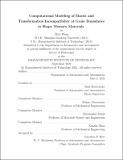Computational Modeling of Elastic and Transformation Incompatibility at Grain Boundaries in Shape Memory Materials
Author(s)
Wang, Zhiyi
DownloadThesis PDF (4.547Mb)
Advisor
Radovitzky, Raúl
Terms of use
Metadata
Show full item recordAbstract
Shape memory alloys (SMAs) and zirconia-based ceramics (SMCs) find a wide range of applications in various fields due to their unique properties such as superelasticity and shape memory effect. Desirable superelastic properties of shape memory materials are realized to their maximum extent in single crystalline structures due to the absence of internal constraints. By contrast, in polycrystalline forms, superelasticity is significantly compromised by severe premature intergranular fracture originated at grain boundaries. This limitation has drawn significant research interests in developing microstructures that can preserve the properties of single crystals while avoiding the production cost and manufacturing limitations of single-crystal processing.
The overarching goal of the thesis is to improve our understanding of the competition between martensitic transformation, grain boundary constraints, and intergranular fracture in shape memory materials through comprehensive computational modeling. To this end, we developed a finite-element based framework for modeling martensitic transformation at the continuum level incorporating details of the micromechanical information. A single-crystal model is implemented to provide a full mechanistic three-dimensional description of both the anisotropic elastic and martensitic transformation stress-strain response, including the non-Schmid behavior observed in some types of SMCs. We used the geometrically nonlinear theory of martensite to identify all possible transformation systems in SMAs and SMCs, based on the knowledge of lattice parameters of the single crystal. In the case of SMCs, the model was calibrated against data obtained from compression tests of zirconia micropillars in previously published literature. We conducted finite element simulations to obtain detailed information on the nucleation and evolution of martensite variants and stress distribution at grain boundaries in both SMAs and SMCs. The simulation results also provide insights on the competing mechanisms of elastic and transformation incompatibility leading to severe stress concentration at grain boundaries. We identified grain boundary configurations which result in very large stress 3 concentrations at very low deformations due to elastic incompatibility, as well as others where the elastic incompatibility is relatively low and stress concentrations only occur at large transformation strains. We also showed how this approach can be used to explore the misorientation space for quantifying the level of elastic and transformation incompatibility at grain boundaries in both SMAs and SMCs. In addition, we investigated the correlation between different types of incompatibilities and grain boundary characteristics. In the particular case of SMAs, we explored the role that a coincident site lattice (CSL) may have in affecting grain boundary incompatibilities. We demonstrated that grain boundaries with low CSL order exhibit low elastic incompatibilities in Cu-based SMAs, as previously suggested from experimental observations. However, high CSL order grain boundaries result in incompatibilities that are commensurate with those exhibited by random grain boundary configurations. This approach could be used to identify misorientations that reduce or minimize grain boundary incompatibilities, thus extend the superelastic range of the material.
Date issued
2022-09Department
Massachusetts Institute of Technology. Department of Aeronautics and AstronauticsPublisher
Massachusetts Institute of Technology